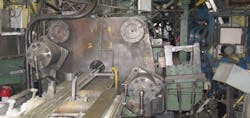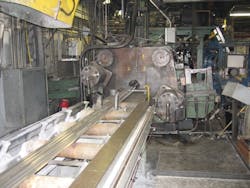Mike Bray is an automation engineer at CPU Automation in Tyngsboro, Mass.
This was the case recently at Silver City Aluminum in Taunton, Mass., a third-generation, family-owned and -operated manufacturer of custom aluminum extrusions and finished parts. Silver City's 50,000 ft² facility houses a range of extrusion, fabrication and finishing operations. These include transforming raw aluminum into thousands of tooled profiles; performing numerous secondary CNC milling, punching and various other multi-station operations; and painting.
Figure 1: Large rolls of aluminum — called billets — are fed into the extrusion machine, pressed into a die using hydraulic power, and heated. It emerges as a slat, blind, or other shaped-aluminum product.
Source: Silver City Aluminum
"Unlike other more-costly and time-consuming metal-forming methods, extrusion can be tooled within two to four weeks at costs typically ranging from $1,000 to $3,000," explains Larry Johnson, Silver City Aluminum's maintenance manager. "In addition to being cost-effective and time-efficient, the extrusion process is also pretty straightforward. Large rolls of aluminum — called billets — are fed into the extrusion machine, pressed into a die using hydraulic power, and heated. It emerges as a slat, blind, or other shaped-aluminum product (Figure 1)."
Shaving Can Cause Problems
After the billet has been pressed into the die and heated for about a minute, a knife drops down, guillotine-style, and shaves off the excess 3–4 in. of aluminum. At least, that's what's supposed to happen.
"Occasionally, after a billet has been cut, the excess fails to fall off," Johnson says (Figures 2/3). "When this hanging piece hits the die, it can destroy it — to the tune of about $10,000 in replacement costs — or cause the machine to shut down, leading to expensive production losses."
Figure 2: After the billet has been pressed into the die and heated for about a minute, a knife drops down, guillotine-style, and shaves off the excess aluminum. Occasionally, the excess fails to fall off and could damage the die to the tune of about $10,000 in replacement costs.
Source: Silver City Aluminum
The challenge for Silver City was to find an inspection solution that could fit into a space-constrained area, be able to inspect a large area, and perform reliably in harsh environmental conditions while not breaking the bank.
The existing sensing solution had problems. Not only was the photoelectric sensor solution unable to perform reliably in this manufacturing environment, it wasn't able to map the entire surface of the billet to determine whether a completely clean cut had been made. After testing other photoelectric sensing solutions, Johnson decided to bring in his automation supplier CPU Automation for assistance.
Cameras the Smart Answer
Upon reviewing the problem, we determined that a different type of solution was needed, and installed a dual-camera inspection system using BOA smart cameras from Teledyne Dalsa.
"Incorporating all of the elements of an industrial machine vision system in a tiny, smart-camera-style package, the BOA is an integrated optical inspection tool for controlling quality and increasing productivity," says Fernando Serra, Teledyne Dalsa's Eastern region sales manager. "The BOA is easy to use, and is a cost-effective solution designed specifically for use in harsh factory floor environments."
When a billet leaves the oven, it is automatically loaded onto the extrusion machine. One BOA camera looks at the billet as it is loaded into the press to ensure that it enters the extruder properly. If it is improperly loaded, the camera alerts the PLC to stop the press, and an operator manually repositions and restarts the machine. The press itself is located directly in front of a large window, so infrared lights are used to help reduce glare and reflections. This provides the camera a clearer view of the billet, and prevents harm to workers' eyes.
The other camera takes images of the knife when it drops to cut the billet and when it returns to its original position — a one-minute cycle from start to finish due to the size of the billet and the nature of the extrusion process.
"If the image indicates that the excess aluminum was sheared off, then the hydraulic press and plunger resume operations automatically," Johnson says. "If the image shows that the billet was not cut properly, the BOA sends a message to a hardwired PLC, which stops the machine and activates an alarm to alert workers of the problem. Human intervention is required only when the vision system detects an incorrect cut and triggers the PLC alarm."
Software Tools
The system also is connected via Ethernet TCP/IP to Johnson's PC, allowing him to control the camera from his desk. Since iNspect application software is built directly into the camera, Johnson can program it via an easy-to-use web interface. "I just line it up where the image looks best, and then I can see what's happening on the machine from my office," he says. "I make any adjustments that are needed from my desktop. It's really easy to use this system. Very little training time was required — maybe an hour or two — before I felt completely comfortable running and editing applications."
The BOA software contains an extensive library of tools for solving most vision applications. Silver City uses a simple pattern-matching technique. "We look at a clean cut and teach the system to run that specific pattern," Johnson says. "The image gets a score of 100% if it's an exact match to the original template. If there are any variations from the original template image — meaning if there is any aluminum present after the billet is cut — the BOA alerts the PLC to a failure."
Well Worth It
The BOA system has been up and running for nearly a year and, during that time, Silver City Aluminum has not lost a dollar due to a damaged die or machine downtime. "Before we installed this vision system, we would be lucky to get through a month without a crash and breakdown," Johnson says. "These cameras have been 100% reliable. We've had no downtime and no production loss, which were our two requirements for this system."
About the Author
Mike Bray
Mike Bray

Leaders relevant to this article:


